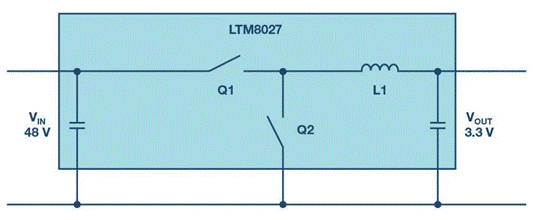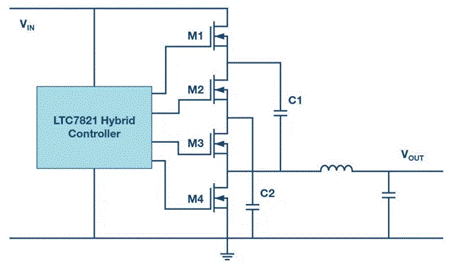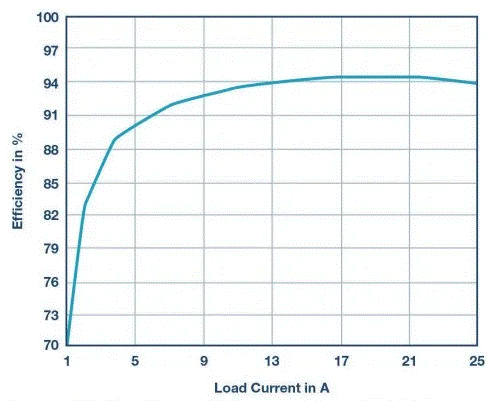For applications that require conversion from high input voltage to very low output voltage, there are different solutions. An interesting example is the conversion from 48 V to 3.3 V. Such specifications are common not only in server applications in the information technology market, but also in telecommunications applications.
If a buck converter (buck) is used for this single conversion step, as shown in Figure 1, a small duty cycle problem occurs.

The duty cycle reflects the relationship between the on time (when the main switch is on) and the off time (when the main switch is off). The duty cycle of the buck converter is defined by the following formula:

When the input voltage is 48 V and the output voltage is 3.3 V, the duty cycle is about 7%.
This means that at a switching frequency of 1 MHz (1000 ns per switching period), the on-time of the Q1 switch is only 70 ns. Then, the Q1 switch is off 930 ns and Q2 is on. For such circuits, a switching regulator that allows a minimum on-time of 70 ns or less must be selected. If such a device is chosen, there is another challenge.
Typically, the step-down regulator's conversion efficiency is reduced when operating with a very small duty cycle. This is because the time available to store energy in the inductor is very short. The inductor needs to provide energy for a long shutdown time. This usually results in a very high peak current in the circuit. To reduce these currents, the inductance of L1 needs to be relatively large. This is due to the fact that during the on-time, a large voltage difference is applied to the L1 ends of Figure 1.
In this example, the voltage at both ends of the inductor during the on-time is approximately 44.7V, the voltage at one side of the switch node is 48V, and the output voltage is 3.3V. The inductance current is calculated by the following formula:

If there is a high voltage at both ends of the inductor, the current in the inductor will rise for a fixed time if the inductor is unchanged. In order to reduce the peak inductance current, it is necessary to select a higher inductance value. However, higher inductance values increase power losses. Under these voltage conversion conditions, the ADI High Efficiency LTM8027 µModule® regulator module achieves only 80% conversion efficiency at 4 A output current.
Currently, a very common and more efficient circuit solution to improve conversion efficiency is to utilize an intermediate voltage. Figure 2 shows a cascading setup using two high-efficiency buck regulators. The first step is to convert the 48 V voltage to 12 V, and then convert that voltage to 3.3 V in the second conversion step. When reduced from 48 V to 12 V, the LTM8027μModule voltage regulator module achieves a total conversion efficiency of more than 92%. The second conversion step uses the LTM4624 to reduce 12 V to 3.3V with a conversion efficiency of 90%. The total conversion efficiency of this scheme is 83%, which is 3% higher than the direct conversion efficiency in Figure 1.

The voltage is reduced from 48 V to 3.3 V in two steps, including a 12 V intermediate voltage
This can be quite surprising, as all the power on the 3.3V output needs to pass through two separate switching regulator circuits. The circuit shown in Figure 1 is less efficient because the duty cycle is short, resulting in a higher peak inductance current.In addition to conversion efficiency, there are many other aspects to consider when comparing a single-step step-down architecture with an intermediate bus architecture.
Another solution to this fundamental problem is the LTC7821, ADI's new hybrid step-down controller, which combines a charge pump with step-down regulation. This allows a duty cycle of 2 times the VIN/VOUT, so a very high step-down ratio can be achieved at a very high conversion efficiency.
Figure 3 shows the circuit setup for the LTC7821. It is a hybrid synchronous step-down controller that combines a charge pump (to halve the input voltage) with a synchronous step-down converter with a step-down topology. When it is used to convert 48 V to 12 V at 500 kHz switching frequency, the conversion efficiency is more than 97%. Other architectures can achieve such high efficiency only at much lower switching frequencies and require larger inductors.

The combination of charge pump and step-down topology has the following advantages:
Due to the optimized combination of charge pump and synchronous switching regulator, the conversion efficiency is very high. External MOSFETs M2, M3 and M4 only need to withstand low voltages. The circuit is also very compact. The inductance is smaller and cheaper than the single-stage converter method. For this hybrid controller, the duty cycle of switches M1 and M3 is D = 2×VOUT/VIN. For M2 and M4, the duty cycle is D = (Vin-2 x VOUT)/VIN.
For charge pumps, many developers assume a power output limit of about 100 mW. Circuits designed with the LTC7821's hybrid converter switch can provide up to 25 A output current. For higher performance, multiple LTC7821 controllers can be connected in a parallel polyphase configuration, and the frequencies are synchronized to share the overall load.

The hybrid buck controller offers very high conversion efficiency in a compact form. It offers an interesting alternative to discrete two-stage switching regulator designs with intermediate bus voltages, and single-stage converters that operate at very low duty cycles. Some designers prefer cascading architectures, while others prefer hybrid architectures. With these two options, every design should be successful.
免责声明: 本文章转自其它平台,并不代表本站观点及立场。若有侵权或异议,请联系我们删除。谢谢! Disclaimer: This article is reproduced from other platforms and does not represent the views or positions of this website. If there is any infringement or objection, please contact us to delete it. thank you! |


